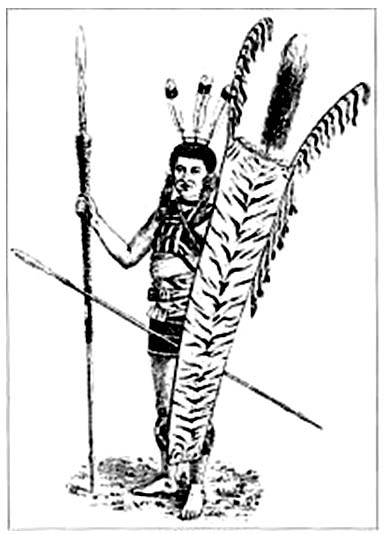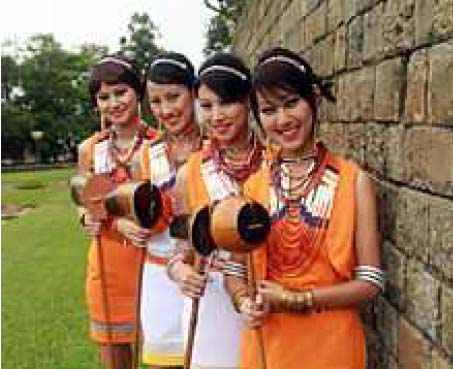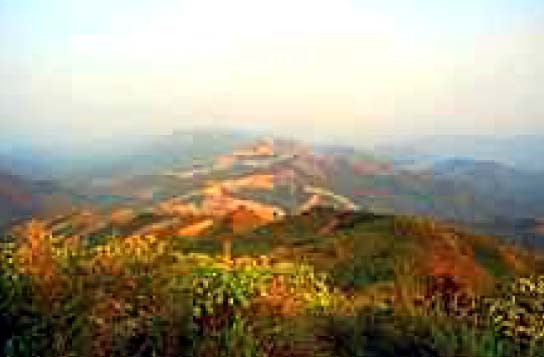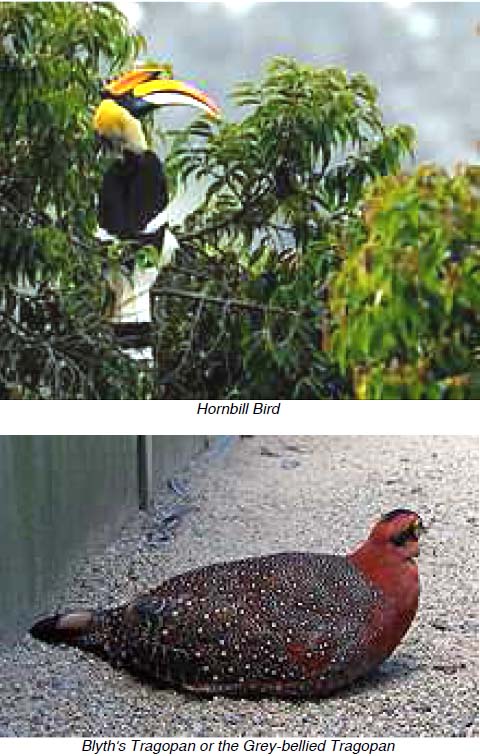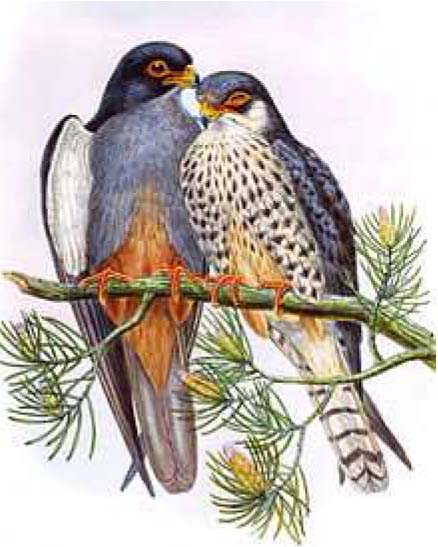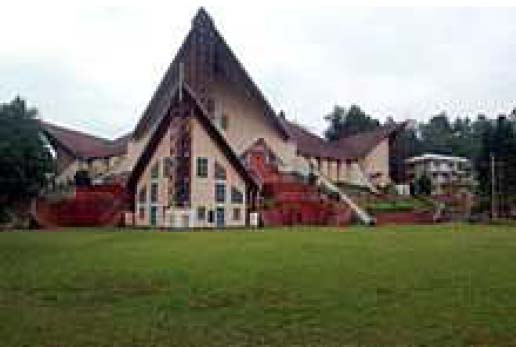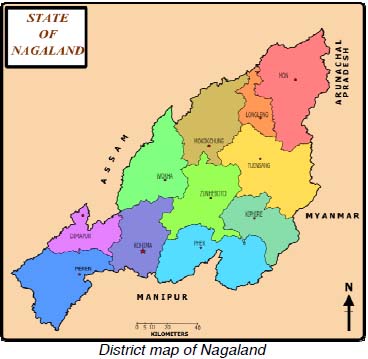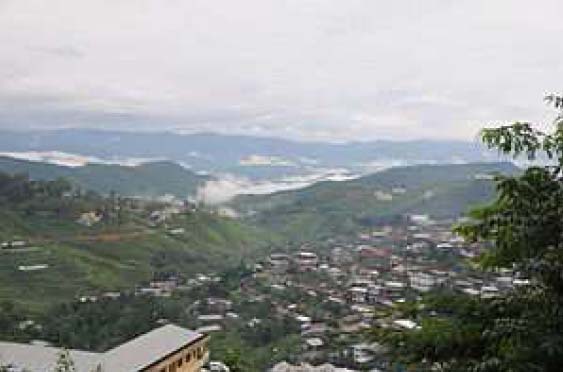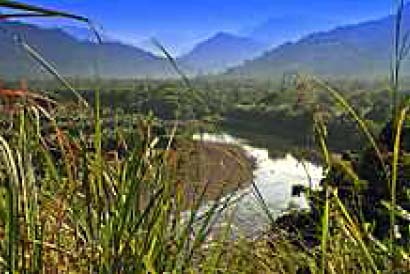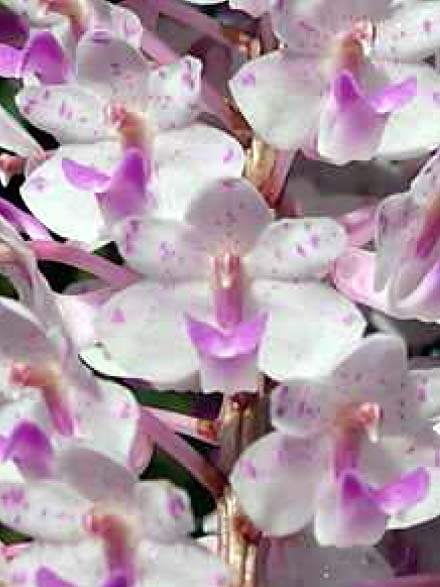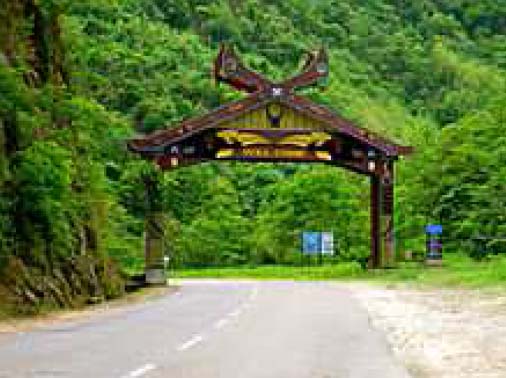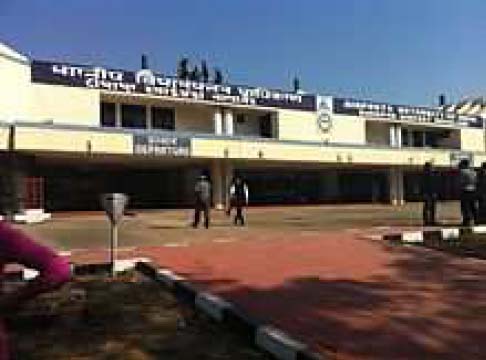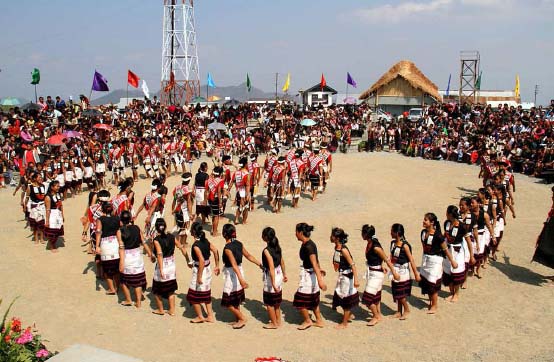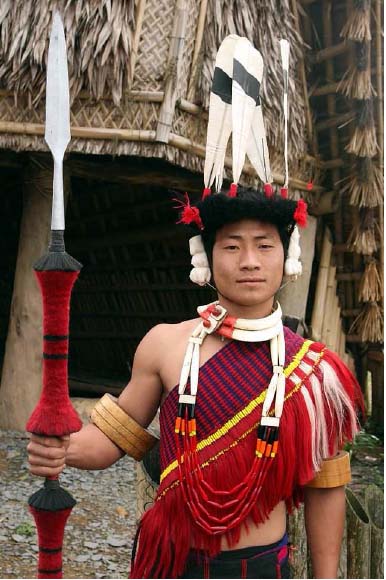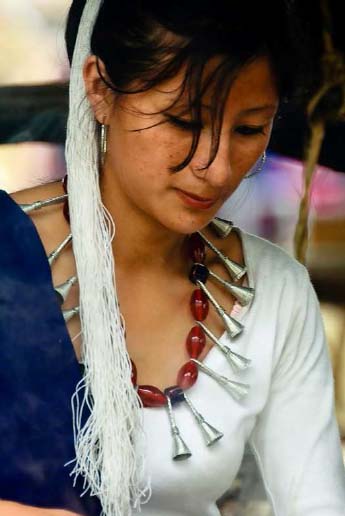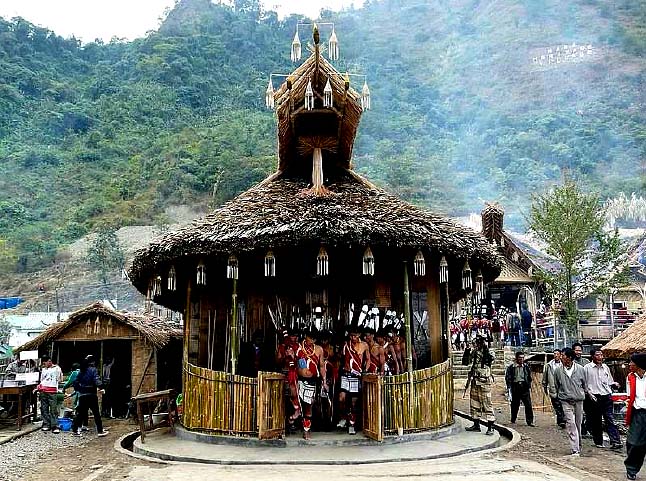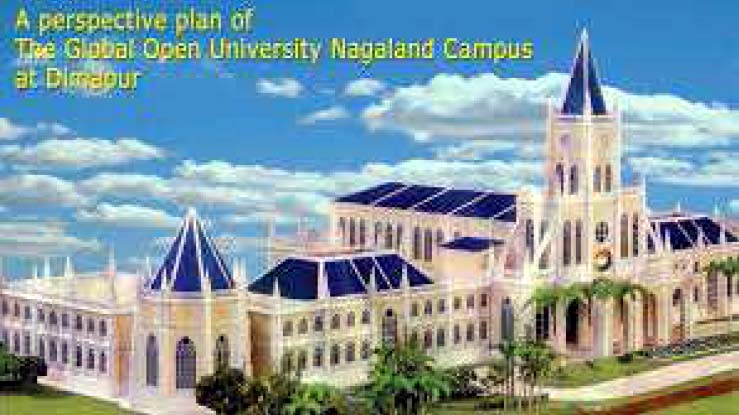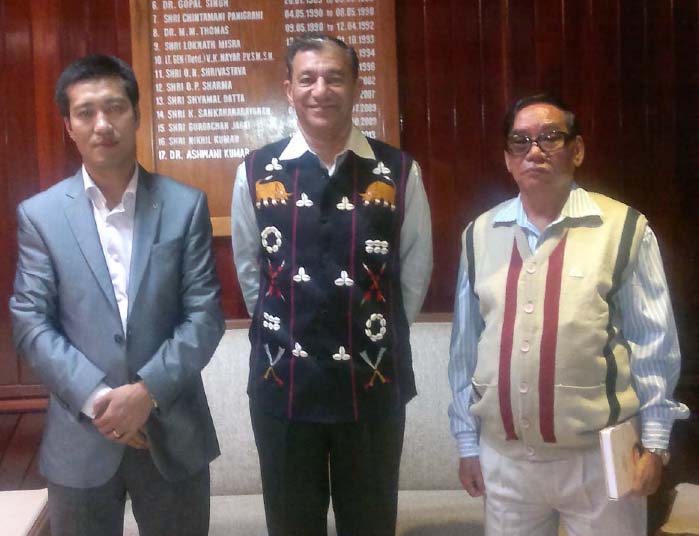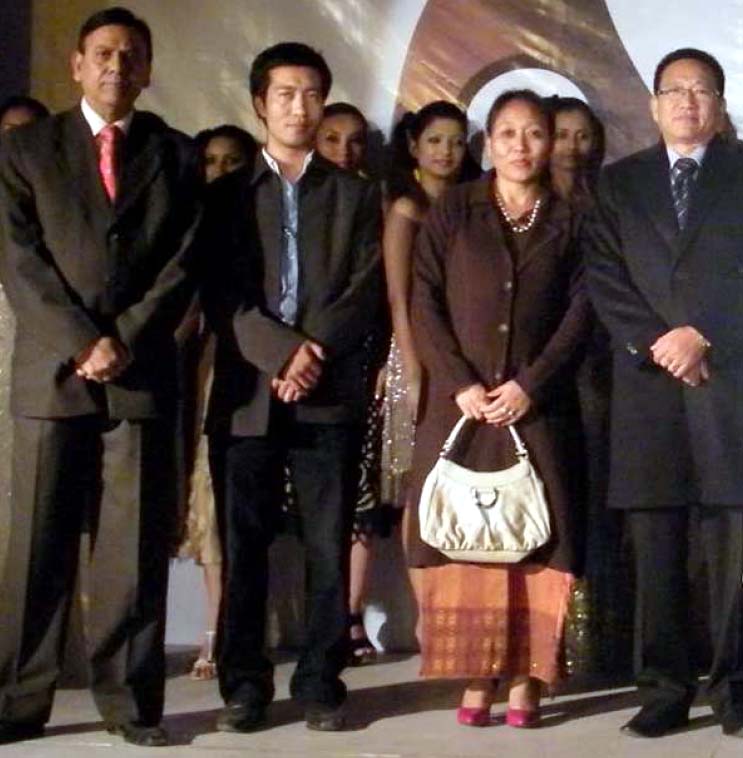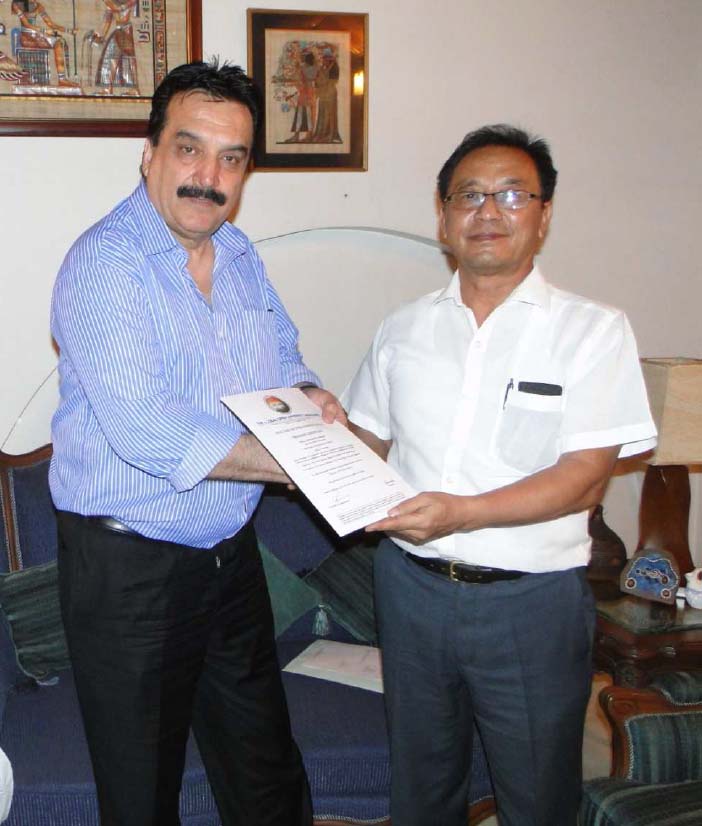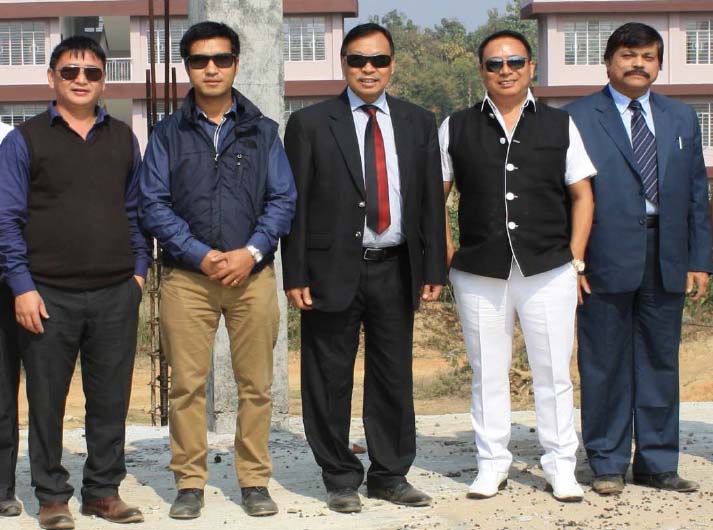|
A sketch of Angami Naga tribesman from 1875.
The ancient history of the Nagas is unclear. Ancient Sanskrit scriptures mention Kiratas, or golden skinned people, with distinct culture, who live in the mountains of east after migrating from distant lands. Some anthropologists suggest Nagas belong to the Mongoloid race, and different tribes migrated at different times, each settling in the north-eastern part of present India and establishing their respective sovereign mountain terrains and village-States. There are no records of whether they came from far north Mongolian region, Southeast Asia or Southwest China, except that their origins are from the East of India and that historic records show the present day Naga people settled before the arrival of the Ahoms in 1228 AD.
The origin of the word ‘Naga' is also sketchy. A popularly accepted, but controversial view is that it originated from the Burmese word ‘Naka’, meaning people with earrings. Others suggest it means pierced noses.
Before the arrival of European colonialism in South Asia, there had been many wars, persecution and raids from Burma on Naga tribes, Meitei people and others in India's northeast. The invaders came for "head hunting" and to seek wealth and captives from these tribes and ethnic groups. When the British inquired Burmese guides about the people living in northern Himalayas, they were told ‘Naka’. This was recorded as ‘Naga’, and has been in use thereafter.
With the arrival of British East India Company in early 19th century, followed by the British Raj, Britain expanded its domain over entire South Asia including the Naga Hills. The first Europeans to enter the hills were Captains Jenkins and Pemberton in 1832. The early contact with the Naga tribes were of suspicion and conflict. The colonial interests in Assam, such as tea estates and other trading posts suffered from raids from tribes who were known for their bravery and "head hunting" practices. To put an end to these raids, the British troops recorded 10 military expeditions between 1839 and 1850. In February 1851, at the bloody battle at Kikrüma, numerous people died both on the British side as well as the Kikrüma Naga tribe side; in days after the battle, inter-tribal warfare followed that led to more bloodshed. After that war, the British first adopted a policy of respect and non-interference with Naga tribes. This policy failed. Over 1851 to 1865, Naga tribes continued to raid the British in Assam. The British India Government, fresh from the shocks of 1857 Indian rebellion, reviewed its governance structure throughout South Asia including its northeastern region. In 1866, the British India administration reached the historic step in Nagaland's modern history, by establishing a post at Samaguting with the explicit goal of ending inter-tribal warfare and tribal raids on property and personnel. In 1869, Captain Butler was appointed to lead and consolidate the British presence in the Nagaland hills. In 1878, the headquarters were transferred to Kohima - creating a city that remains to this day an important center of administration, commerce and culture for Nagaland.
In 1879, a British Officer Damant focussed on the tribe in Khonoma village. He went to Khonoma with his troops, where he was shot dead along with 35 of his team. Kohima was next attacked and stockade looted. This violence led to a determined effort by the British Raj, to return and respond. The subsequent defeat of Khonoma marked the end of serious and persistent hostility in the Naga Hills. Between 1880 and 1922, the British administration consolidated their position over a large area of the Naga Hills and integrated it into its Assam operations. The British administration enforced Rupee as the currency for economic activity and system of structured tribal Government that was very different than historic social governance practices. These developments triggered profound social changes among the Naga people.
In parallel, since mid 19th century, Christian missionaries from United States and Europe, stationed in India, reached out into Nagaland and neighboring States, playing their role in converting Nagaland's Naga tribes from Animism to Christianity. Road to statehoodAfter the independence of India in 1947, the area remained a part of the province of Assam. Nationalist activities arose amongst a section of the Nagas. Phizo-led Naga National Council and demanded a political union of their ancestral and native groups. The movement led to a series of violent incidents, that damaged Government and civil infrastructure, attacked Government officials and civilians. The Union Government sent the Indian Army in 1955, to restore order. In 1957, an agreement was reached between Naga leaders and the Indian Government, creating a single separate region of the Naga Hills. The Tuensang frontier were united with this single political region, Naga Hills Tuensang Area (NHTA), and it became a Union territory directly administered by the Central Government with a large degree of autonomy. This was not satisfactory to the tribes, however, and agitation with violence increased across the State – including attacks on army and Government institutions, banks, as well as non-payment of taxes. In July 1960, following discussion between the then Prime Minister Jawahar Lal Nehru and the leaders of the Naga People Convention (NPC), a 16-point agreement was arrived at whereby the Government of India recognised the formation of Nagaland as a full-fledged State within the Union of India.
Accordingly, the territory was placed under the Nagaland Transitional Provisions Regulation, 1961 which provided for an Interim body consisting of 45 members to be elected by various tribes according to the customs, traditions and usage of the respective tribes. Subsequently, Nagaland attained Statehood with the enactment of the State of Nagaland Act in 1962 by the Parliament. The interim body was dissolved on 30 November 1963 and the State of Nagaland was formally inaugurated on 1 December 1963 and Kohima was declared as the State capital. After elections in January 1964, the first democratically elected Nagaland Legislative Assembly was constituted on 11 February 1964.
The rebel activity continued, in the form of banditry and attacks, motivated more by tribal rivalry and personal vendetta than by political aspiration. Cease-fires were announced and negotiations continued, but this did little to stop the violence. In March 1975, direct presidential rule was imposed by the then Prime Minister Indira Gandhi on the State. In November 1975, the leaders of largest rebellion groups agreed to lay down their arms and accept the Indian constitution; a small group did not agree and continued their insurgent activity. The Nagaland Baptist Church Council played an important role by initiating peace efforts in 1960s. This took concrete and positive shape during its Convention in early 1964. It formed the Nagaland Peace Council in 1972.
However, these efforts have not completely ended the inter-factional violence. In 2012, the State's leaders approached Indian Central Government to seek a political means for a lasting peace within the State.
Over the 5 year period of 2009 to 2013, between 0 to 11 civilians died per year in Nagaland from rebellion related activity (or less than 1 death per 100,000 people), and between 3 to 55 militants deaths per year in inter-factional killings (or between 0 and 3 deaths per 100,000 people). The world's average annual death rate from intentional violence, in recent years, has been 7.9 per 100,000 people. The most recent Nagaland Legislative Assembly election took place on 23 February 2013 to elect the Members of the Legislative Assembly (MLA) from each of the 60 Assembly Constituencies in the State. Nagaland People's Front was elected to power with 37 seats. . Geography
Mountainous terrain of Nagaland Nagaland is largely a mountainous State. The Naga Hills rise from the Brahmaputra Valley in Assam to about 2,000 feet (610 m) and rise further to the southeast, as high as 6,000 feet (1,800 m). Mount Saramati at an elevation of 12,601.70 feet (3,841.00 m) is the State's highest peak; this is where the Naga Hills merge with the Patkai Range in Burma. Rivers such as the Doyang and Diphu to the north, the Barak river in the southwest and the Chindwin river of Burma in the southeast, dissect the entire State. 20 percent of the total land area of the State is covered with wooded forest, rich in flora and fauna. The evergreen tropical and the sub tropical forests are found in strategic pockets in the State. Climate
Nagaland has a largely monsoon climate with high humidity levels. Annual rainfall averages around 70–100 inches (1,800–2,500 mm), concentrated in the months of May to September. Temperatures range from 70 °F (21 °C) to 104 °F (40 °C). In winter, temperatures do not generally drop below 39 °F (4 °C), but frost is common at high elevations. The State enjoys a salubrious climate. Summer is the shortest season in the State that lasts for only a few months. The temperature during the summer season remains between 16 °C (61 °F) to 31 °C (88 °F). Winter makes an early arrival and bitter cold and dry weather strikes certain regions of the State. The maximum average temperature recorded in the winter season is 24 °C (75 °F). Strong north-west winds blow across the State during the months of February and March. Flora and Fauna
About a million Amur Falcon, Falco peregrinus, roost
in Nagaland. Nagaland is rich in flora and fauna. About one-sixth of Nagaland is under the cover of tropical and sub-tropical evergreen forests—including palms, bamboo, rattan as well as timber and mahogany forests. While some forest areas have been cleared for jhum cultivation, many scrub forests, high grass, reeds; secondary dogs, pangolins, porcupines, elephants, leopards, bears, many species of monkeys, sambar, harts, oxen, and buffaloes thrive across the State's forests. The Great Indian Hornbill is one of the most famous birds found in the State. Blyth's Tragopan, a vulnerable species of pheasant, is the State Bird of Nagaland. It is sighted in Mount Japfü and Dzükou Valley of Kohima district, Satoi range in Zunheboto district and Pfütsero in Phek district. Of the mere 2500 tragopans sighted in the world, Dzükou valley is the natural habitat of more than 1,000.
Mithun (a semi domesticated Gaur) found only in the north-eastern States of India, is the State animal of Nagaland and has been adopted as the official seal of the Government of Nagaland. It is ritually the most valued species in the State. With a vision to conserve and protect this magnificent animal in the northeast, the National Research Centre on Mithun (NRCM) was established by the Indian Council of Agricultural Research (ICAR) in 1988.
DemographyThe population of Nagaland is nearly two million people, of which 1.04 million are males and 0.95 million females. Among its various districts, Tuensang has the largest population (414,000), followed by Kohima (314,000). The least populated district is Phek (148,000). 75% of the population lives in the rural areas. As of 2013, about 10% of rural population is below the poverty line; among the people living in urban areas 4.3% of them are below the poverty line.
The State showed a population drop between 2001 census to 2011 census, the only State to show a population drop in the census. This has been attributed, by scholars, to incorrect counting in past censuses; the 2011 census in Nagaland is considered most reliable so far. LanguagesNagaland has more language diversity than any other State in India. Naga people speak over 36 different languages and dialects, mostly unintelligible with each other. Per Grierson's classification system, Naga languages can be grouped into Western, Central and Eastern Naga Groups. The Western Group includes among others Angami, Chokri and Kheza. The Central Naga group includes Ao, Lotha and Sangtam, while Eastern Group includes Konyak and Chang. In addition, there are Naga-Bodo group illustrated by Mikir language, and Naga-Kuki group of languages illustrated by Sopvama (also called Mao Naga) and Luppa languages. These belong to mostly Tibeto-Burman and some Sino-Tibetan family of languages. Shafer came up with his own classification system for languages found in and around Nagaland. In 1967, the Nagaland Assembly proclaimed English as the official language of Nagaland and it is the medium for education in Nagaland. Other than English, Nagamese, a creole language form of Indo-Aryan Assamese, is a widely spoken language. Every tribe has its own mother tongue but communicates with other tribes in Nagamese or English. The "Kaccha Nagas" of Manipur communicate with each other in Meitei, the common language of the people of Manipur. However, English is the predominant spoken and written language in Nagaland. Religion
A Cathedral in Kohima City. About 75% of Nagaland people are Baptists. Christianity is the predominant religion of Nagaland. The State's population is 1.988 million, out of which 90.02% are Christians. The census of 2001 recorded the State's Christian population at 1,790,349, making it, with Meghalaya and Mizoram, one of the three Christian-majority States in India and the only State where Christians form 90% of the population. The State has a very high church attendance rate in both urban and rural areas. Huge churches dominate the skylines of Kohima, Dimapur, and Mokokchung.
Nagaland is known as "the only predominantly Baptist State in the world." Among Christians, Baptists are the predominant group, constituting more than 75% of the State's population, thus making it more Baptist (on a percentage basis) than Mississippi in the southern United States, where 55% of the population is Baptist. Roman Catholics, Revivalists, and Pentecostals are the other Christian denomination numbers. Catholics are found in significant numbers in parts of Wokha district and Kohima district as also in the urban areas of Kohima and Dimapur.
Christianity arrived in Nagaland in early 19th century. The American Baptist Naga mission grew out of Assam mission in 1836. Miles Bronson, Nathan Brown and others in Christian missionaries working out of Jaipur, to bring Christianity into Indian subcontinent, saw the opportunity for gaining converts since India's northeast was principally Animist and folk religion driven. Along with other tribal regions of the northeast, Nagaland people accepted Christianity. However, the conversions have been marked by high rates of re-denomination ever since. After having converted to Christianity, people do not feel bound to any one sect, switch affiliation between a variety of denominations. According to a 2007 report, breakaway churches are constantly being established alongside older sects. These new Christian churches differ from older ones in terms of their liturgical traditions and methods of worship. The younger churches exhibit a more vocally explicit form of worship. The Constitution of India grants all citizens, including Nagaland people, a freedom to leave, change or adopt any religion and its new sects.
Hinduism and Islam is also found in Nagaland. They are minority religions in the State, at 7.7% and 1.8% of the population respectively. An ancient indigenous religion known as the Heraka is followed by 4,168 people belonging to the Zeliangrong tribe living in Nagaland. Rani Gaidinliu was a freedom fighter who struggled for the revival of the traditional Naga religion of animism or Heraka. Today, 94% of the Kuki tribe people living in Nagaland are Christian. Administration
The Governor is the constitutional head of State, representative of the President of India. He possesses largely ceremonial responsibilities apart from law and order responsibilities. The Legislative Assembly of Nagaland (Vidhan Sabha) is the real executive and legislative body of the State. The 60-member Vidhan Sabha – all elected members of legislature – forms the Government executive and is led by the Chief Minister. Unlike most States in India, Nagaland has been granted a great degree of State autonomy, as well as special powers and autonomy for Naga tribes to conduct their own affairs. Each tribe has a hierarchy of councils at the village, range, and tribal levels dealing with local disputes.
Districts – District Headquarters
Urban Centres
Kohima City, Nagaland The major urban areas of Nagaland are Dimapur, Kohima, Mokokchung, Tuensang, Wokha, Mon, Zunheboto, Longleng and Kiphire. There are four urban agglomeration areas with population of more than 40,000 in the State:
Major towns that are non-district headquarters include Tuli town,Mangkolemba, Naganimora, Changtongya, Tizit, Tseminyu, Bhandari, Akuluto, Pfutsero, Aboi, Tobu. Economy
42% of Nagaland is covered by forests. Forest and agriculture are primary drivers of its economy.
The Gross State Domestic Product (GSDP) of Nagaland
was about
Nagaland has a high literacy rate of 80.1 per cent. Majority of the population in the State speaks English, which is the official language of the State. The State offers technical and medical education. Nevertheless, agriculture and forestry contribute majority of Nagaland's Gross Domestic Product. The State is rich in mineral resources such as coal, limestone, iron, nickel, cobalt, chromium, and marble. Nagaland has a recoverable reserve of limestone of 1,000 million tonnes plus a large untapped resource of marble and handicraft stone. Several preliminary studies indicate significant recoverable reserves of petroleum and natural gas. However, these resources are not in the project or development pipeline yet.
Most of State's population, about 68 per cent of the total, depends on rural cultivation. The main crops of the State are rice, millet, maize, and pulses. Cash crops, like sugarcane and potato, are also grown in some parts. Plantation crops such as premium coffee, cardamom, and tea are grown in hilly areas in small quantities, but a large growth potential. Most people cultivate rice as it is the main staple diet of the people. About 80% of the cropped area is dedicated to rice. Oil seeds is another, higher income crop gaining ground in Nagaland. The farm productivity for all crops is low, compared to other Indian States, suggesting significant opportunity for farmer income increase. Currently the Jhum to Terraced cultivation ratio is 4:3; where Jhum is local name for cut-and-burn shift farming. Jhum farming is ancient, causes a lot of pollution and soil damage, yet accounts for majority of farmed area. The State does not produce enough food, and depends on trade of food from others States of India.
Forestry is also an important source of income. Cottage industries such as weaving, woodwork, and pottery are also an important source of revenue.
Tourism has a lot of potential, but largely limited due to insurgency and concern of violence over the last five decades. Nagaland's gross State domestic product for 2004 is estimated at $1.4 billion in current prices.
Kopou phool (Rhynchostylis retusa), a type of orchid, in bloom. Nagaland is home to 396 species of orchids, belonging to 92 genera of which 54 having horticultural and medicinal economic importance. Kopou is also used for festive hairstyle decoration by women in India's northeast. The State generates 87.98 MU compared to a demand for 242.88 MU. This deficit requires Nagaland to buy power. The State has significant hydroelectric potential, which if realized could make the State a power surplus State. In terms of power distribution, every village and town, and almost every household has an electricity connection; but, this infrastructure is not effective given the power shortage in the State.
Transportation infrastructureThe railway network in the State is minimal. Broad gauge lines run 7.98 miles (12.84 km), National Highway roads 227.0 miles (365.3 km), and State roads 680.1 miles (1,094.5 km). Road is the backbone of Nagaland's transportation network. The State also has over 15,000 km of surfaced roads, but these are not satisfactorily maintained given the weather damage. In terms of population served for each kilometer of surfaced road, Nagaland is the second best State in the region after Arunachal Pradesh.
RailwaysRailway: North East Frontier Railway
[Data Source: N. F. Railway, CME Office, Guwahati-781011] Highways and towns servedNational highways: 227.0 miles (365.3 km)
Highway into Nagaland State highways: 680.1 miles (1,094.5 km)
Dimapur Airport Departures
Airways
CultureThe sixteen main tribes of Nagaland are Angami, Ao, Chakhesang, Chang, Dimasa Kachari, Khiamniungan, Konyak, Lotha, Phom, Pochury, Rengma, Sangtam, Sumi, Yimchunger, Kuki and Zeliang. The Konyaks, Angamis, Aos, Lothas, and Sumis are the largest Naga tribes; there are several smaller tribes as well (see List of Naga tribes). Tribe and clan traditions and loyalties play an important part in the life of Nagas. Weaving is a traditional art handed down through generations in Nagaland. Each of the tribe has its own unique designs and colours, producing shawls, shoulder bags, decorative spears, table mats, wood carvings, and bamboo works. Among many tribes the design of the shawl denotes the social status of the wearer. Some of the more known shawls include Tsungkotepsu and Rongsu of the Ao tribe; Sutam, Ethasu, Longpensu of the Lothas; Supong of the Sangtams, Rongkhim and Tsungrem Khim of the Yimchungers; the Angami Lohe shawls with thick embroidered animal motifs etc. Folk songs and dances are essential ingredients of the traditional Naga culture. The oral tradition is kept alive through the media of folk tales and songs. Naga folks songs are both romantic and historical, with songs narrating entire stories of famous ancestors and incidents. There are also seasonal songs which describe various activities done in a particular agricultural season. Tribal dances of the Nagas give an insight into the inborn Naga reticence of the people. War dances and other dances belonging to distinctive Naga tribes are a major art form in Nagaland Festivals
An Angami festival dance in progress.
A Naga man dressed for his festival.
A Naga woman dressed for her festival. Nagaland is known in India as the land of festivals. The diversity of people and tribes, each with their own culture and heritage, creates a year long atmosphere of celebrations. In addition, the State celebrates all the Christian festivities. Traditional tribe-related festivals revolve round agriculture, as a vast majority of the population of Nagaland is directly dependent on agriculture. Some of the significant festivals for each major tribe are:
Historical ritualsHistorically, Naga tribes celebrated two main rituals. These were feasting and head hunting.
Head hunting Head hunting, a male activity, would involve separating men from their women before, during and after coming back from an expedition. The women, as a cultural practice, would encourage men to undertake head-hunting as a prerequisite to marriage. The men would go an expedition against other tribes or neighboring kingdoms, and kill to score number of heads they were able to hunt. A successful head hunter would be conferred a right to ornaments. The practice of head hunting was banned in 19th century India, and is no longer practiced among Naga people.
Feasts of Merit The Feasts of Merit reflected the splendor and celebration of Naga life. Only married men could give such Feasts, and his wife took a prominent and honored place during the ritual which emphasized male-female cooperation and interdependence. His wife brewed the beer which he offered to the guests. The event displayed various ceremonies and festivities organized by the sponsor. The Feast given by a wealthier tribes person would be more extravagant. He would typically invite everyone from the tribe. This event bestowed honor to the couple from the tribe. After the Feast, the tribe would give the man and his wife rights to ornaments equally.Hornbill Festival of Nagaland
Nagaland Hornbill Festival in progress at the Naga Heritage Village. Hornbill Festival was launched by the Government of Nagaland in December 2000 to encourage inter-tribal interaction and to promote cultural heritage of the State. Organized by the State Tourism Department and Art and Culture Department. Hornbill Festival showcases a mélange of cultural displays under one roof. This festival takes place between 1 to 7 December every year.
It is held at Naga Heritage Village, Kisama which is about 12 km from Kohima. All the tribes of Nagaland take part in this festival. The aim of the festival is to revive and protect the rich culture of Nagaland and display its history, culture and traditions.
The Festival is named after the Hornbill bird, which is displayed in folklores in most of the States tribes. The week long festival unites one and all in Nagaland and people enjoy the colourful performances, crafts, sports, food fairs, games and ceremonies. Traditional arts which include paintings, wood carvings, and sculptures are also on display. Festival highlights include Traditional Naga Morungs Exhibition and sale of arts and crafts, food stalls, herbal medicine stalls, shows and sales, cultural medley – songs and dances, fashion shows, beauty contest, traditional archery, naga wrestling, indigenous games and musical concerts. Additional attractions include the Konyak fire eating demonstration, pork-fat eating competitions, the Hornbill Literature Festival (including the Hutton Lectures), Hornbill Global Film Fest, Hornbill Ball, Choral Panorama, North East India Drum Ensemble, Naga king chilli eating competition, Hornbill National Rock Contest, Hornbill International Motor Rally and WW-II Vintage Car Rally.
Hon’ble Chief Minister of Nagaland
A Perspective Plan of The Global Open University Nagaland Campus at National Highway, Dimapur.
Hon’ble Governor of Nagaland Dr. Ashwani Kumar with
the Registrar Dr. Imotemsu Ao and
Hon’ble Chief Minister of Nagaland Mr. T.R. Zeliang
with the officials and the students on the occasion of
Hon’ble Chancellor of The Global Open University Nagaland Mr. T.N. Mannen conferring the Degree Certificate on a successful participant from Afghanistan Mr. Hafizullah Wali Rahimi who researched on the correlation between the Competition Legislation of India and Afghanistan.
Hon’ble Minister for PWD (Roads and Bridges) and Parliamentary Affairs Government of Nagaland Mr. Kuzholuzo Nienu (Azo) and Hon’ble Parliamentary Secretary, Higher Education and SCERT, Government of Nagaland Mr. Deo Nukhu inspecting the New Campus of The Global Open University Nagaland at the National Highway, Dimapur.
|
History of Nagaland



